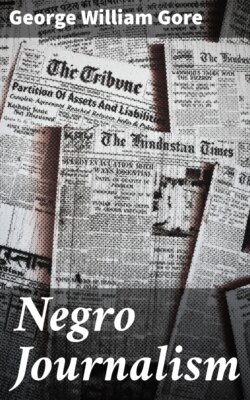Читать книгу Negro Journalism - George William Gore - Страница 5
На сайте Литреса книга снята с продажи.
CHAPTER I
EARLY NEGRO NEWSPAPERS
ОглавлениеTable of Contents
Freedom’s Journal
Seven years after Benjamin Lundy began The Genius of Universal Emancipation, and four years before William Lloyd Garrison started to publish The Liberator, Negro Journalism in America was born. The first publication was Freedom’s Journal[1], issued March 16, 1827. It was in form a medium-sized, neat-looking, well-printed weekly, about nine by twelve inches. Freedom’s Journal was a thorough-going abolitionist sheet, having been called into being to defend the Negro against the vile attacks of a New York editor of Jewish descent who had pro-slavery and Negro-hating tendencies. This new organ had for its motto, “Righteousness Exalteth a Nation,” and its columns were filled with long dissertations on the immorality of slavery.
John Russwurm First Editor
The editor, John Russwurm, one of the first Negroes to graduate from a college in the United States, graduated from Bowdoin College in 1826. Russwurm was born in Jamaica in 1799. He published The Journal until 1829, when he went to Liberia, where he became editor of The Liberia Herald.
The Colored American
A period of about eight years elapsed before the founding of a second Negro newspaper. In January, 1837, Rev. Samuel Cornish began the publishing of The Weekly Advocate. The name was changed in March, however, to The Colored American, and under that name it continued to be issued weekly until 1842. The first editor, Rev. Cornish, was one of the leading Negro journalists of the period. He had been associated with Freedom’s Journal, and throughout a period of twenty years he was actively connected with some newspaper.
Advocated Emancipation
The subscription price of The Colored American was two dollars per year in advance. Its objects were, according to its flag, “the moral, social and political elevation of the free Colored people; and the peaceful emancipation of the enslaved.” The paper was well received by the American press of the period, and many favorable comments on it appeared from time to time.
The Elevator
The first two Negro newspapers had their headquarters in New York City, but their successor was established in Albany, N. Y. The Elevator came into being in 1842, with Stephen Myers as its publisher. The paper was strongly backed by the Abolitionists. Among its influential supporters and backers was Horace Greeley of The New York Tribune.
The National Watchman
Contemporaneous with The Elevator appeared The National Watchman and Clarion, which was established in Troy, N. Y., in the latter part of 1842. Its publisher and editor was William G. Allen. It was short-lived, as was also The People’s Press which was published by Thomas Hamilton in New York City the following year.
The Mystery
Following the lead taken by the empire state, Pennsylvania became a field of activity for the Negro journalist. In 1843, The Mystery was published at Pittsburgh by Dr. Martin Delaney, a graduate of Harvard College. At first it was conducted as the personal property of its editor, but as such it survived only nine months when it became necessary to transfer its ownership to a joint-stock company. After the change Delaney was retained in the capacity of editor.
Delaney was the first Negro editor to be sued for libel. He was fined for his statements; but his popularity was so great that the fine was paid by popular subscription.
The Mystery ceased publication under that name in 1848, at which time it was purchased by the African Methodist Episcopal Church.
Statement by N. Y. Sun, Origin of The Ram’s Horn
As the result of a statement by the editor of The New York Sun, “The Sun shines for all white men and not for colored men,” in January, 1847, The Ram’s Horn was begun. Its editor was Willis Hodges, who according to The Afro-American Press and Its Editor[2], furnished the money necessary to publish the first issue by whitewashing in New York City for two months. Within a short period of time the circulation of the paper reached two thousand five hundred copies. The subscription price was $1.50 to subscribers within the state, and $1 a year to those outside the state. Its motto was—“We are men, and therefore interested in whatever concerns men.” The publication was a five column folio, printed on both sides. It suspended publication in June 1848.
[1] March 21, 1828, the name was changed to Rights of All.
[2] Published by I. Garland Penn in 1891.
